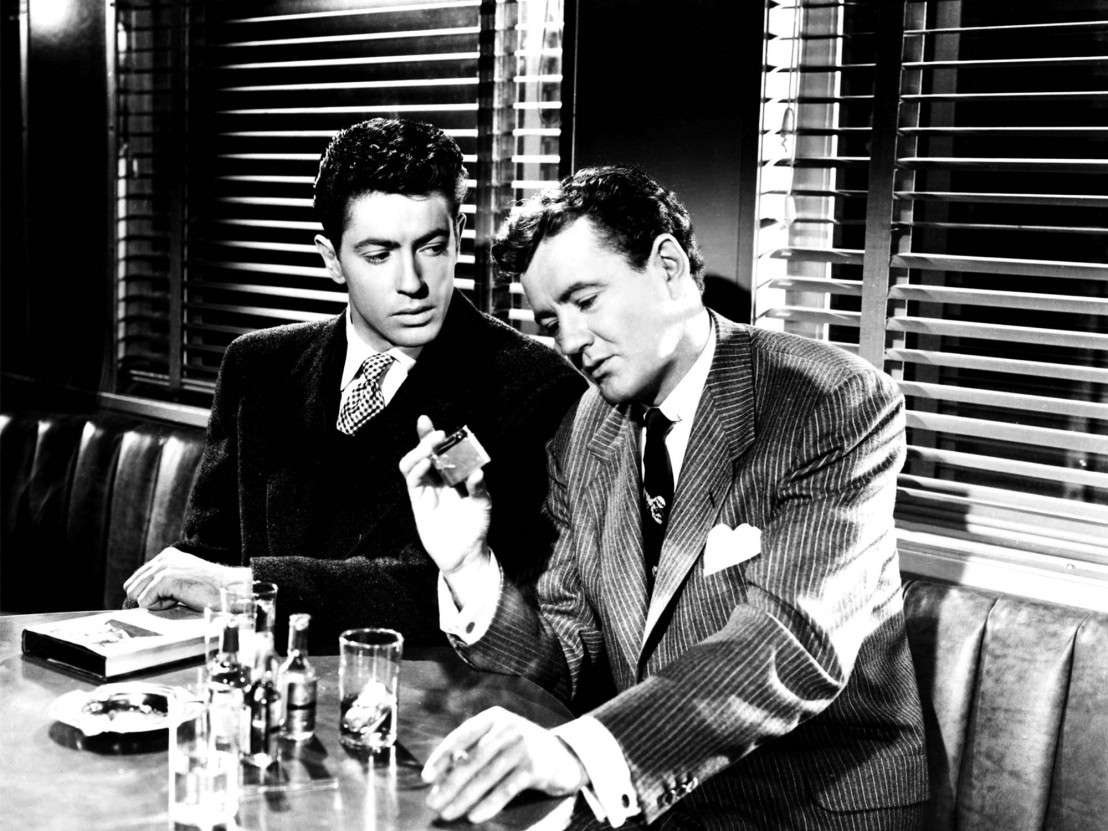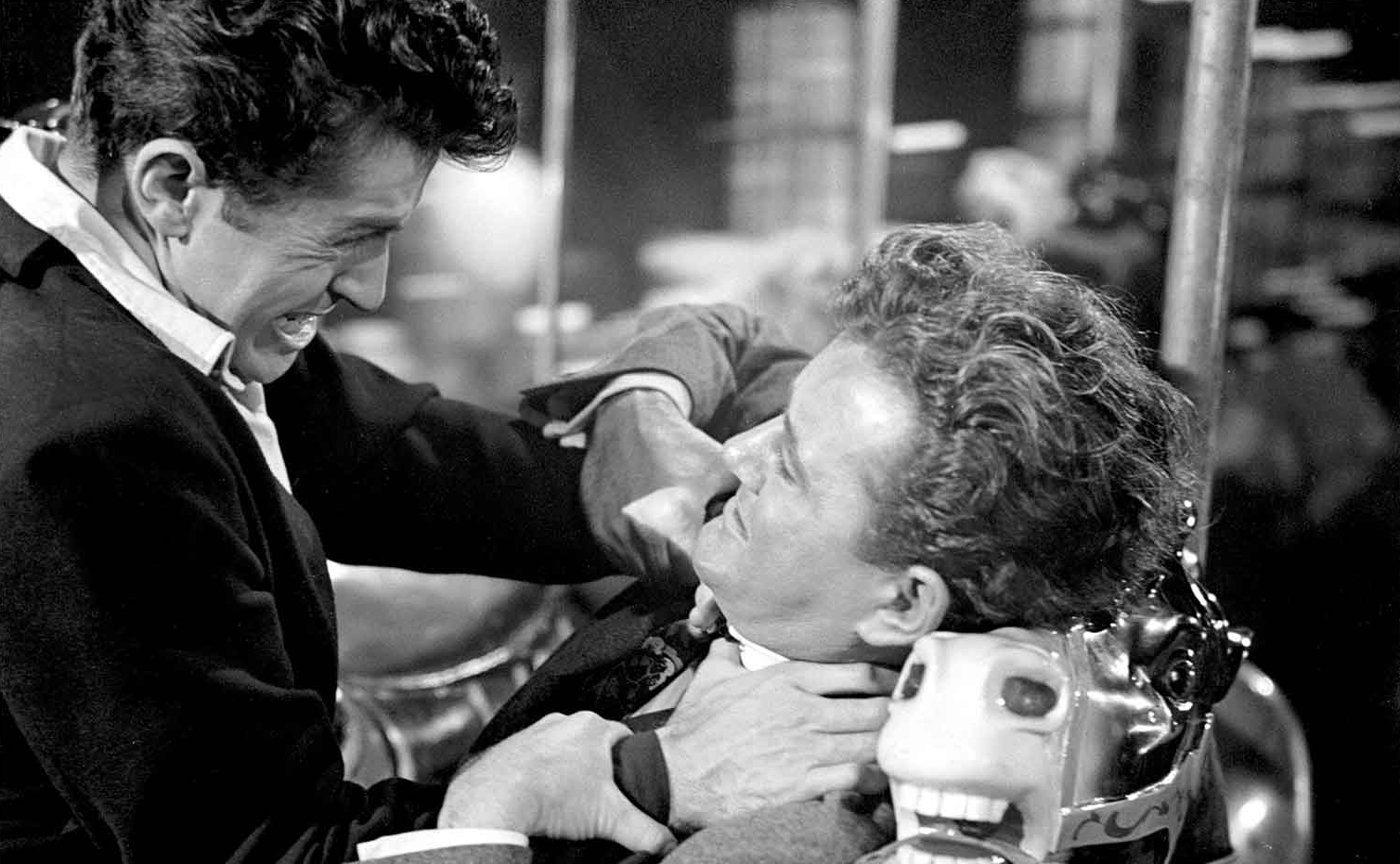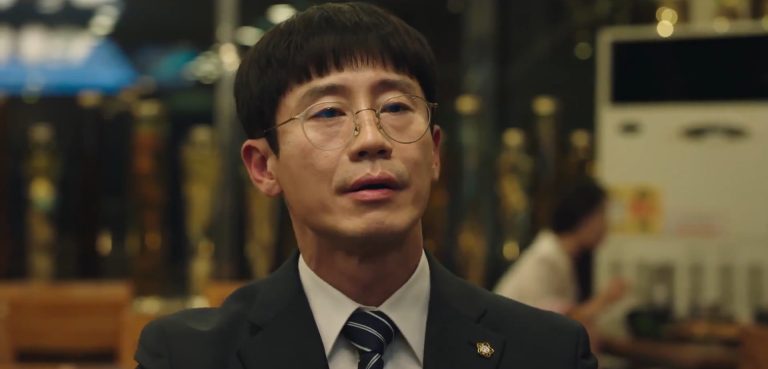“People, feelings, everything! Double! Two people in each person. There’s also a person exactly the opposite of you, like the unseen part of you, somewhere in the world and he waits in ambush.”
Patricia Highsmith’s words from her debut novel most brilliantly sum up the essence of her debut novel, “Strangers on a Train.” Later, Hitchcock secured the rights to the book for $7,500, and it became the cinematic manifestation, released in 1951. Although Hitchcock dispenses with the complex strands of Highsmith’s novel to make it more suitable for the mainstream consuming audience, the complexity is not gotten rid of altogether. “Strangers on a Train” (1951) narrates the story of a tennis star who meets a stranger on his way to a match. Temporarily buoyed up by the stranger’s veneration, the tennis star entertains him too much until he finally and painfully recognizes the terrible trap into which he has fallen.
Strangers on a Train (1951) Plot Summary & Movie Synopsis:
Guy Haines, a budding tennis sensation, is on his way to Southampton for his doubles when he meets Bruno Anthony on a train. Despite being a complete stranger, Bruno Anthony shows affinity towards Haines and his life, albeit in a way that is too intrusive. Anthony quickly owns up to his glitch: he is too friendly. When both Haines and the spectators pardon him for his seemingly innocuous flaw, Anthony starts to reveal the sinister undercurrent of his overfriendliness.
Anthony begins by proclaiming his resentment towards his father and quickly shifts the topic to Haines’ divorce. Haines puts up a front of prudish respectability as Anthony tosses around casually his ideas of a perfect murder. Anthony points out that hypothetically, if Haines considers the thought of killing his wife, what prevents his thought from materializing as an action is his fear of being caught. Haines’ uncomfortable but rather flabby protestations are shoved aside as Anthony reveals his idea: “Two fellows meet accidentally, like you and me. No connection. Never saw each other before. Each one has somebody that he’d like to get rid of. So…they swap murders.”
Anthony continues on the idea of swapping murders and presses on its effectiveness as the murderers, on account of being total strangers, will never be caught as there is no clear motive or connection. Haines gives little importance to Anthony’s ‘crisscross’ theory and leaves. However, his sarcastic approval of Anthony’s idea appears to be a positive signal to Anthony. Before deboarding, a forgetful Haines leaves his lighter behind, and Anthony does not bat an eyelid before claiming it.
Also, Read: The Critical Re-reading of Alfred Hitchcock’s Vertigo (1958)
Before boarding a train bound for Southampton, Haines is in Metcalf to meet his wife, Miriam, and rescind their vows. It is suggested that their marriage has fallen apart due to her extra-marital affair. She is also having a baby of not Haines but someone else. However, Miriam is parasitic, too, and is not ready for a divorce. She becomes livid when she learns that Haines is in love with the Senator’s daughter, Anne Morton. Scurrilous as ever, Miriam threatens to malign Haines and Anne by claiming to the court that Haines has started an affair with the Senator’s daughter by deserting the pregnant wife.
Haines, unable to hide his frustration, later calls Anne and says– in a fit of rage– that he could strangle Miriam. That evening, Anthony calls Haines from his house and, without winding too much, inquires him directly about his divorce. Haines hangs up. In the background, we see Anthony’s parents in a disagreement over their son’s mental state, where his father presses on the urgency of the treatment of his condition.
Anthony arrives in Metcalf in search of Miriam. Miriam, flirtatious with all men, spots Anthony in the amusement park as she is out with two other men. Anthony follows Miriam as she goes on a boating ride with her companions. When she gets off at an island, Anthony strangles her to death. All this happens while Haines is on the train from New York to Washington. When Haines arrives home at night, he notices Anthony in the dark calling out for him. Anthony gives him Miriam’s broken eyeglasses, and Haines understands that Anthony has indeed acted on his theory by killing Miriam. When Haines tries to call the police, Anthony says he cannot do it since he is complicit in the crime. In fact, Anthony now asks Haines to do the second murder– the murder of Anthony’s father.
Haines is called over to the Morton household, and Anne’s father breaks the news of Miriam’s death to him. Anne says that the police have been trying to locate him. Barbara, Anne’s sister, warns of the possibility of Haines being the police’s suspect as he had an obvious motive. Haines says he has an alibi, a professor from Delaware Tech. He also details the little conversation they had.
However, at the police station, the alibi does not hold up as the professor was inebriated at the time of the encounter and fails to recall Haines. The police station an escort officer to keep an eye on Haines around the clock. Bruno Anthony, on the other hand, is relentlessly pursuing Haines. He lurks like a shadow wherever Haines goes. Haines receives letters from Bruno reminding him of his duty to kill Bruno’s father, a map to their house highlighting his father’s bedroom with the key taped, and a pistol.

Before Haines can ward off the evil, Anthony introduces himself to Anne Morton. However, Anne notices the change of attitude that Anthony has when he sees Barbara. Anthony shows up at the Morton’s party uninvited. His penchant for conversations around murder concerns the guests. In one instance, he tries to demonstrate to one guest the effectiveness of strangling as a murder method. However, when his eyes meet Barbara’s, he drifts away to the night of Miriam’s murder and unconsciously re-enacts the way he strangled Miriam. The guest is almost killed. Anne understands that Barbara’s spectacled face, which resembled the face of Miriam, could have triggered Anthony.
Unable to deal with Anthony’s obsessions and sinister motives, Haines stealthily goes into their house and tries to warn his father. However, he finds Anthony in his father’s bedroom instead, waiting for him. Meanwhile, Haines’ absence from his own house in the dead of the night adds to the pile of circumstantial evidence against him. Anne visits Anthony’s and tries to explain to his mother that he has killed a woman. His mother pays little attention to Anne’s concerns.
Bruno concocts a story around the missing lighter and tells Anne that Haines implored him to remove the lighter from the murder site to obliterate his involvement. When Anne tells this to Haines, he instinctively understands Anthony’s plan of placing the lighter to convict Haines. Anne advises him to drop out of the day’s match and head towards Metcalf before Anthony. However, Haines insists on playing as not playing would further incriminate him to the law enforcement keeping watch. Instead, he plays the match, wins it, and slips out just in time to be in Metcalf with the help of Anne and Barbara.
Strangers on a Train (1951) Movie Ending Explained:
Does Bruno Anthony succeed in incriminating Haines with the lighter?
When Anthony arrives at the amusement park, a carnival worker recognizes him from the night of the murder. However, when he points that out to the police, they misunderstand him and think that he is pointing towards Haines. Haines arrives and spots Anthony getting on an already spinning merry-go-round. He chases Anthony and goes into the live carousel himself. The police try to aim at Haines but miss the aim and kill the carousel operator instead.
This causes the carousel to spin out of control. A carnival worker ventures underneath the carousel to stop it, which causes the spinning carousel to get uprooted. A fatally injured Anthony is buried underneath the debris. Clearing out the confusion, the carnival worker points out Bruno as the man whom he remembers. Bruno, still refusing to own up to his crime, dies, and the police find the lighter as he releases the grip of his fist. Haines is exonerated. The film ends with Haines on a train, this time accompanied by Anne. As a stranger recognizes him like Bruno Anthony and tries to make a conversation, Haines, leery of the consequences, moves away.
Strangers on a Train Themes Analysed:
Does Bruno Anthony’s character have an implicit working?
Return of the Repressed

Before Haines leaves for the last match, he has a quick conversation with Anne. The wooden board of the stadium, presumably the entrance to Wimbledon’s centre court, that is visible above their heads is decorated with the words: “And treat those two impostors just the same”. It is a line from the poem ‘If’ by Rudyard Kipling. This, in fact, stirred up a lingering question for me: is the one who made Haines made Anthony, too? And, if that is indeed true, is Haines also an impostor?
Much of the simmering unease and anxiety of “Strangers on a Train” can be explicated by the Freudian notion of the ‘uncanny’ or the ‘return of the repressed.’ For Freud, “the ‘uncanny’ is that class of the terrifying which leads back to something long known to us, once very familiar.” This means that the common pitfall in understanding ‘uncanny’ is the reductive deduction that it is the unease caused by the unknown. Uncanny is not simply concerning the unknown. The once-known is subdued and made into the unknown, so when the newly fashioned unknown returns, it brings to mind ancient bugbears.
Furthermore, the themes of uncanny correspond to the motif of the ‘double.’ The ‘double,’ Freud argues, arises at a particular juncture of the child’s developmental stage. The ego development takes place by the process of subsuming the primary narcissism, an unchecked form of self-love, of the child. As the child now turns to its parents for established cultural and ethical ideals, it leaves behind the infantile narcissism that demands the child consider itself its own ideal. This is how the ‘ego ideal’ forms. The ‘double’ takes on a ghastly connotation– what is described as ‘uncanny’– when a man, having long been past the stage of primary narcissism, somehow finds himself encountering that primitive stage in adulthood.
In the film, Bruno perhaps brings to the surface the repressed murderous desires of Haines. In a film that largely plays on literal doubles, he brings to mind the psychoanalytic conception of the ‘double.’ When Bruno suggests swapping the murders and goes on to kill Miriam, Bruno becomes a substitute self for Haines and not the other way round, as Haines never kills Bruno’s father. In fact, when Bruno suggests the idea of murder first on the train, nowhere does he make explicit the manner of strangling as the best possible method. Instead, he dwells on light sockets in the bathroom or carbon monoxide in the garage but not strangling.
When the bitter encounter between Haines and Miriam around the talk of divorce turns against Haines, we see a frustrated Haines avowing in a fit of rage his desire to break Miriam’s neck over a phone call to Anne. This conversation is not even remotely audible to Anthony, who, in the next scene, we see is seated in his lavish house, getting his nails filed by his mother. However, the shot of Anthony loudly proclaiming “I could strangle her” dissolves into a close-up of Anthony’s hands with his mother’s remark: “I do wish you’d keep your hands quiet”.
Something from the previous scene of Haines bleeds into the shot of Anthony’s hands: almost a transference of mental processes from Haines to Anthony. Later, we see Anthony killing Miriam by breaking her neck, exactly as Haines had wished. Freud’s observation, an assurance of immortality once the double assumes the role of the uncanny harbinger of death, closely aligns with the logic that governs the lurking figure of Bruno Anthony.
Repressed homosexuality
By virtue of being a film noir, the repressed in “Strangers on a Train” returns in another form. While forming his expositions on masculinity and homosexuality in film noirs, James Naremore notes that despite the Motion Picture Production Code of the 1940s imposing an inflexible forbiddance on the depiction of homosexuality on screen, the psychological thrillers and horrors movies ushered in plenty of characters with homosexual overtones, even though they were treated with disdain. The homosexuals are almost always the villains or the sinister forces in the films.
It would not escape one’s notice that Bruno Anthony is dandified. He gets his nails filed by his mother and never leaves an opportunity to profess his obsession and liking for Haines. The effects are implicit but all too obvious to the spectators. Moreover, through the depiction of Anthony’s unwavering affection for his mother and extreme loathing for his father, the film adheres to Freud’s conception that male homosexuality is the result of a son’s unresolved romantic attachment to his mother.








